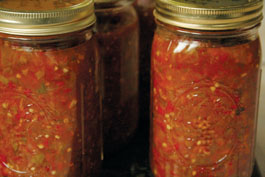home | metro santa cruz index | santa cruz county restaurants | review

Photograph by Ari LeVaux
Chip in : Forty pounds of tomatoes, 3 pounds of carrots and six heads of garlic are the starting point for 12 months' supply of salsa.
Nightshade Sauce
Ari LeVaux puts up a year's worth of salsa.
By Ari LeVaux
When harvest season arrives, I hit the farmers market like a sailor hits a strip club: with a fistful of dollars I never want to see again. And while I enjoy spending those dollars, I also bring the fun home with me, where it can last for months. This week, I'm dead-set on amassing a year's worth of salsa.
By "year's worth of salsa," I mean about 20 quarts, or two batches in my 3-gallon pot. That's just for me, a normal guy who takes his salsa in hearty but reasonable doses on his eggs and corn chips. Some people, like my friend Shorty, can sit down with a jar of salsa and a spoon and those 20 quarts will be gone before you can say "buenos nachos." Because of Shorty, I actually try to put up several years' worth of salsa each year.
The active ingredients in salsa are tomatoes and peppers, both of which hail from a family of crops called nightshades, which also include eggplants and potatoes. Nightshades often go well together, in cooking and in storage. A stash of potatoes and homemade catsup, for example, makes for a classy December snack, while an abundance of market eggplants and tomatoes could be transformed into stored batches of ratatouille, frozen or canned. Well, ratatouille was last week, and pickled peppers are next week, so this week I hit the market ready to fork over the equivalent of a fancy night on the town, about $100, for the makings of my yearly stash of spicy nightshade sauce.
Your quantity of tomatoes and peppers determines your onion, carrot and garlic requirements. The ratio of tomato to pepper should be about one-to-one in terms of volume, or three parts tomato to one part pepper by weight. For 40 pounds of tomatoes, you'll want 10 large onions, 3 pounds of carrots and six heads of garlic.
Any tomato will do, but juicy, high-acid canning tomatoes are ideal. Your choice of peppers should be tailored to your heat tolerance and embrace diversity, representing as many shapes, colors, sizes and flavors as possible.I learned the ways of nightshade sauce from Roy, a friend, used-car dealer and Willie Nelson look-alike. Over the years I've wandered from Roy's path, as most grasshoppers do when they leave the monastery, nixing cumin and tomatillos from the recipe, for example. Nonetheless, Roy's process lives on in my jars.
"Ahh done really now hwhat aam doin," he says of this process, in a humble Georgia twang thick enough to get your truck stuck in. "Ahh jus throw sum she-it in jawrs."
Roy's basic unit of measurement is the food processor load. As in: "five loads a tomatoes, five loads a peppers, two loads a onions, one load a carrots, half a load a garlic." Then, keep adding loads of peppers and tomatoes until the pot is full.
The more diverse your selection of peppers, the more complex the finished product will be. Ye of little heat tolerance can assemble a posse of mild, sweet and medium varieties. Roy uses jalapeņos, bells, Anaheims, wax, big chiles, little chiles, cups of crushed dried chile peppers, crumbled handfuls of dried whole chile peppers, including a few habaņeros, and for good measure, a can of Mexican-style pickled carrots and peppers, all run through the processor. When you make salsa with Roy, you need to wear rubber gloves, and wash your hands before--not just after--using the bathroom.
Like Roy, I like my salsa extra-extra-hot. The flavors behind the heat are extraordinary. Plus, I get off on the endorphins. Most importantly, it slows down Shorty, who would otherwise mainline my stash.
When the pot is nearly full, mix the contents, turn on the heat and bring it to a boil, stirring and scraping often to prevent scalding. While heating, add a bunch of chopped cilantro, a cup of minced garlic and salt and pepper to taste. Sometimes, a la Roy, I add a jar of homemade pickled carrots and peppers. This year, for a special treat, I went with 30 large roasted green chiles, chopped coarsely and added just after the salsa had come to a boil.
Turn off the heat, ladle the salsa into hot sterilized jars and screw on the sterilized rings and lids. The jars will seal as they cool.
Soon you'll gaze upon your new stash of salsa while you listen to a symphony of pings as the jars seal. Consider all the future meals your salsa will improve. Reflect on the good time that began at market earlier that day with nothing but a wad of cash, and turned into a good time that will keep on giving all year long.
Send a letter to the editor about this story.
|
|
|
|
|
|